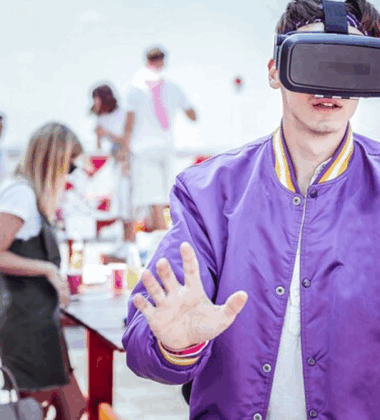As culinary boundaries continue to blur between food, science, and storytelling, one innovation is redefining the way we experience food at trade shows: sensory booths. These immersive installations blend technology, taste, and emotion to engage all five senses—and they’re quickly becoming a must-see feature at global expos like the Food and Beverage Expo USA, taking place from June 26–28, 2025, at the New Jersey Expo Center.
No longer satisfied with passive sampling, today’s consumers and buyers want to feel food with their whole bodies—from sound and scent to texture and even memory. Sensory booths deliver on that promise. For exhibitors, this trend represents not just a design opportunity, but a strategic leap in how to create meaningful, memorable brand experiences.
What Are Sensory Booths?
Sensory booths are interactive, immersive spaces that are designed to stimulate multiple senses simultaneously—taste, smell, sight, sound, and touch. Built at the intersection of culinary arts, experience design, and emerging technologies, these booths transform standard food samples into choreographed experiences.
Elements can include:
- Scent-diffusion systems triggered by visitor movement
- Soundscapes that enhance or shift flavor perception
- Textured surfaces and interactive installations
- Projection mapping for storytelling and mood creation
- Augmented or virtual reality overlays
- Flavor sequencing that matches environmental changes
These sensory environments create emotional resonance and deepen product recall—an essential goal for food and beverage brands competing for attention in a crowded expo setting.
Why Sensory Booths Are Dominating Food Trade Shows
At events like the Food and Beverage Expo USA, the stakes are high. Exhibitors need to stand out, connect emotionally, and drive conversations that extend far beyond the expo floor. Here’s why sensory booths are proving so effective:
1. They Drive Deeper Engagement
While traditional booths offer samples and product brochures, sensory booths invite participation. Visitors stay longer, ask more questions, and become active participants in the brand narrative. When people feel a sense of discovery and delight, they form stronger memory associations with the product.
2. They Amplify Storytelling
Every product has a story—about its origin, its ingredients, its mission. Sensory booths turn those stories into immersive narratives. Imagine a chocolate brand that recreates the rainforest environment where its cacao is sourced, complete with the sounds of tropical birds, humidity effects, and native music. That experience is far more powerful than any printed banner.
3. They Appeal to Gen Z and Millennial Buyers
Younger audiences are driving a shift in expectations. They don’t just want to see your brand; they want to experience it. Sensory booths align perfectly with the values of these demographics: novelty, interactivity, and authenticity. They also provide highly shareable content that performs well on platforms like TikTok and Instagram.
Real-World Examples from the Expo Floor
At previous international expos, we’ve seen how food tech companies and artisanal brands alike have embraced sensory design. Here are a few standout examples:
1. Plant-Based Dairy Brand Creates “Nostalgia Zones”
Using scent diffusers and background audio tracks, this brand recreated environments tied to childhood memories—like the smell of peanut butter and the sound of a school cafeteria. As visitors tried their products, the environment changed to match the flavor’s emotional association.
2. Tea Company Combines Flavor and Frequency
A premium tea exhibitor used music tuned to specific frequencies that were scientifically designed to enhance the perception of sweetness, bitterness, or umami in their tea blends. Visitors could sample the same tea while listening to different tracks and notice the shift in taste—a technique known as sonic seasoning.
3. Beverage Startup Builds a “Flavor Lab”
In this space, attendees could create their own flavor profiles using scent orbs, LED-guided mixing stations, and touch-sensitive panels that triggered information about ingredients and benefits. The booth blurred the lines between bar, lab, and art installation—resulting in hundreds of social media posts from visitors tagging their creations.
What Makes a Great Sensory Booth?
Not all sensory booths are created equal. To deliver real impact at the Food and Beverage Expo USA, exhibitors must go beyond gimmicks and design with intention. Here are the key elements of a successful sensory installation:
1. Clear Brand Narrative
Technology should never outshine your message. Make sure the experience amplifies your brand’s core values—whether that’s transparency, innovation, heritage, or sustainability.
2. Multi-Sensory Harmony
The best booths don’t just add sound or smell—they integrate multiple senses into one cohesive environment. Everything should work together to guide the visitor’s attention and emotions.
3. Interactive Choice
Give visitors agency. Let them shape their journey, whether by selecting flavor pairings, choosing a soundtrack, or activating different sensory stations.
4. Data Integration
Use sensors or QR code interactions to collect feedback and follow up with leads. Smart sensory booths are not just experiential—they’re measurable.
5. Social Sharing Triggers
Design moments within the booth that are “camera ready”—beautiful lighting, animated displays, branded touchpoints. This ensures visitors become your amplifiers, extending reach far beyond the trade show floor.
How Food Tech Brands Can Leverage Sensory Installations
For food tech companies, sensory booths are a natural extension of their product development philosophy. These brands are already thinking about the future of flavor, nutrition, and sustainability. A sensory booth helps bring those ideas to life in ways that words cannot.
Ideas include:
- Showcasing ingredient technology with interactive tasting modules
- Demonstrating functional benefits of products like adaptogens or probiotics via storytelling environments
- Visualizing the supply chain through immersive, room-scale experiences
- Testing new formulations by allowing visitors to vote on flavors, textures, or formats
For chefs and culinary innovators, sensory booths offer a stage to push creative boundaries—combining gastronomy with design, science, and performance.
Planning Your Sensory Booth for the Food and Beverage Expo USA
If you’re preparing for the 2025 Food and Beverage Expo USA, here are tips for getting started with sensory booth planning:
1. Start With the Experience, Not the Product
Ask: What do I want people to feel, think, and remember? Build backward from that emotional outcome.
2. Collaborate with Experts
Work with sensory designers, audio engineers, scent specialists, or AV teams who understand how to synchronize environments.
3. Budget for Tech and Training
Costs may include interactive hardware, scent cartridges, lighting systems, and specialized staff training. Plan ahead to ensure smooth setup and operation.
4. Pilot the Experience
Test your booth setup before the expo with a small audience. Gather feedback on flow, emotional impact, and technical execution. Refine before launch.
Looking Ahead: The Future of Sensory-Driven Food Marketing
As attention spans shrink and expectations grow, sensory booths will become more essential—not less. They offer a rare chance to connect with audiences in ways that bypass logic and go straight to emotion and memory.
For exhibitors at the Food and Beverage Expo USA, embracing sensory design is no longer a luxury—it’s a competitive advantage. Whether you’re a startup looking to build buzz or a global brand launching a new line, the ability to make people feel your product may be your most valuable differentiator.
Final Thought:
Food is memory. It’s emotion. It’s experience. If your booth isn’t tapping into those truths, you’re missing out on the full potential of what trade show marketing can offer.





